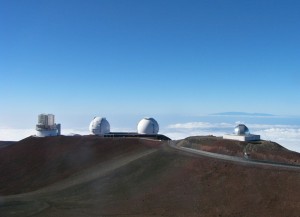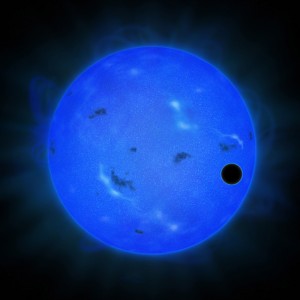
The Subaru telescope sits to the left of the Keck and Infrared observatories, at Mauna Kea’s summit. (Source: Wikimedia Commons)
At the summit of Mauna Kea, Hawaii, the National Astronomical Observatory of Japan’s (NAOJ) Subaru Telescope has been turning its attention to distant worlds. Latest reports of blue-light observations from the telescope indicate that a super-Earth called Gilese 1214b (GJ 1214 b) appears to have a water-rich atmosphere. GJ 1214 b sits forty light years away in the constellation Ophiuchus, northwest of the centre of the Milky Way.

Artist’s rendition of a transit of GJ 1214 b in blue light. The blue sphere represents the host star GJ 1214, and the black ball in front of it on the right is GJ 1214 b. (Credit: NAOJ)
As a “super-Earth”, GJ 1214 b is one of a number of planets that are larger than Earth, but smaller than the Solar System’s gas giants, like Uranus and Neptune. The reported results were obtained by looking at the influence of GJ 1214 b’s atmosphere on scattered light as it passed in front of its star. Changes in the spectrum of light received from the star as the planet passed in transit can be explained in terms of light scattering in its atmosphere, which in turn provides clues as to its formation and birthplace within its star system – hydrogen-rich atmospheres are typical of distant planets, beyond the star system’s “snow line”, for example.

Top: If the sky has a clear, upward-extended, hydrogen-dominated atmosphere, Rayleigh scattering disperses a large portion of the blue light from the atmosphere of the host while it scatters less of the red light. As a result, a transit in blue light becomes deeper than the one in red light.
Middle: If the sky has a less extended, water-rich atmosphere, the effect of the Rayleigh scattering is much weaker than in a hydrogen-dominated atmosphere. In this case, transits in all colors have almost the same transit depths.
Bottom: If the sky has extensive clouds, most of the light cannot be transmitted through the atmosphere, even though hydrogen dominates it. As a result, transits in all colors have almost the same transit depths. (Credit: NAOJ)
Two cameras on the Subaru Telescope were fitted with a blue transmission filter, and found no evidence for strong Rayleigh scattering as GJ 1214 b passed before its star. This implies that it has a water-rich or a hydrogen-dominated atmosphere. Combining the results with earlier data the team concluded that the atmosphere was most likely water-rich, with extensive clouds.
These are the first steps in discovering what sorts of planets these large objects are – are they “super-Earths” or “sub-Neptunes”. Watch out for more news of exo-geology as the results from telescopes like Subaru begin to accumulate.
For more on this story go to http://www.naoj.org/Pressrelease/2013/09/03/index.html
